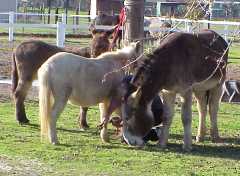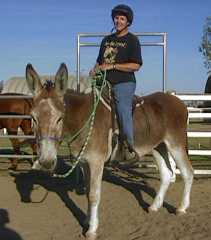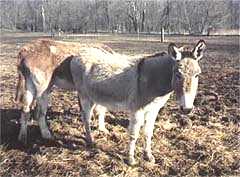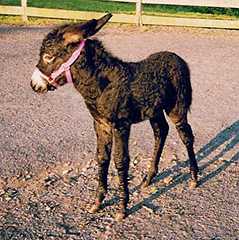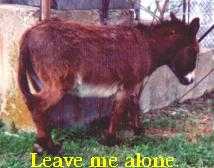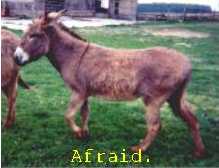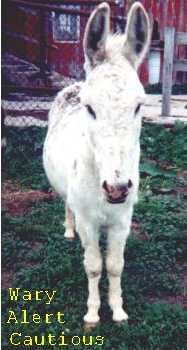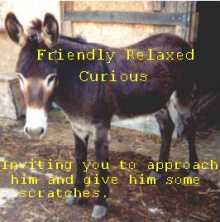"Gentling Wild Donkeys-
|
Gathering around the farrier
|
|
We have found donkeys to be among the most delightful creatures
on the ranch. They definitely make everyone smile more than any
of the other animals. They have distinctive and independent
personalities (donkanalities?), are very smart, and become quite
friendly and cooperative when handled properly.
| |
|
There are over 250 known breeds of donkeys throughout the world. They range in
size from mammoth (nearly draft size) to miniature. In the western United States
free roaming donkeys are generally known by their Spanish name, Burro.
Donkeys are widely used for a variety of purposes ranging from being companion animals to guarding smaller livestock to enjoyable driving and riding animals. They often make good foal companions and since they don't buck, they are even used in handicapped riding programs. Many donkeys (burros) are adopted from the Bureau of Land Management and once socialized to humans and secure in their new environments, they can make themselves quite at home in their new human environment. |
Sharon Lamm and "Zip"
|
| DONKEY PSYCHOLOGY |
|
While donkeys are related to horses, they are socially and behaviorally quite different.
Horses typically live in bands and herds, collectively watching for danger and their primary
survival mechanism is flight. Horses also have a high rate of metabolism and therefore in the
wild they spend three-quarters or more of their day grazing. Donkeys are not swift runners.
They also have a slower rate of metabolism. A wild donkey's defenses include camouflauge (they
spread out, usually in pairs, and visually blend in with the environment), a keen sense of
hearing, a tendency to "size up" a threat and have effective fighting ability. For this last reason
donkeys have been used for centuries to protect small livestock such as goats, sheep and even calves
from predators.
Because of his nature, a donkey will typically not approach new stimulus or learn the same way that a horse does. A donkey will study any new situation. He tends to think independently, confront challenges and push back rather than yield to pressure. It is these very attributes of intelligence and survival that often lend horse trainers the opinion that donkeys are stubborn and stupid. In reality, donkeys are donkeys. You can't effectively train a cat as you would a dog and you can't effectively train a donkey as you would a horse. The purpose of this feature is to provide some insights into how a donkey works and give the reader some idea how to effectively and safely train a donkey. For example, horses typically yield to pressure. A donkey's social behavior is to lean into pressure. This behavior confuses many horse handlers. They try to push the donkey away, "Please move over," and the donkey just pushes right back, "I'm fine, thank you, and it's good to see you too." It is easy to see how the human soon gets frustrated and the donkey becomes disturbed by a species that comes up to say "hello," and then gets upset when the donkey returns the gesture. |
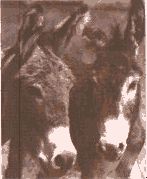
|
|
(Special Thanks to Vicki Knotts Abbott and her Donkey Training E-Clinic for providing some of the information and images used in this feature.) | |
| DONKEY COMMUNICATION |
|
We have discussed how the donkey is more of an independent thinker and doesn't respond to the
same herd instincts as the horse. So how, then, do we motivate the donkey to work with us and
learn how to interact in our environment? If we are using the donkey as a livestock guardian,
we would want his natural responses to remain intact and simply desensitize him to humans so that
we can occasionally provide basic care. However if the donkey is intended to be a pet or
be ridden or driven, We need him to completely adapt to and be comfortable in our social environment. To accomplish this task, we
first have to understand donkey social interaction and to do that, we have to understand donkey communication.
In the wild, donkeys are generally spread out over a huge area. They risk hazards ranging from predators to venomous snakes. Their voices can be heard for over two miles and they are very sensitive to the visual "body language" of other donkeys and of anything that they perceive as being a potential threat. Therefore how we appear to the donkey is an important element of communication as is what he is saying to us. We need to approach the donkey in a relaxed, non predator-like state. Succinct, direct movements can be threatening to many donkeys. Donkeys are also vocal. While they won't become fluent in human language, they will key in to long vowel sounds and the intonation and intensity of our voices. In Vicki Abbott's discussion on communication she presents the illustration of the donkey who has pulled away while being haltered with the human shouting, "No!" and chasing after him. Her point is that to the donkey, this human is signaling danger whereupon they must all get some distance away from the snake (lead rope) that has just been detected and is chasing after them. The donkey's flight in this scenario is therefore predictable. Of course the secret to success here is to understand how to read donkey body language and for us to convey appropriate messages to the donkey so that he doesn't bolt in the first place, and also avoid human-like responses that do little more than reinforce in the donkey's mind that the misbehavior was absolutely the correct thing to do. To understand the donkey's state of mind we have to watch his ears, tail and such subtleties as the way he shifts his body weight. Is the donkey engaging us by looking directly at us or is he looking away and considering his "departure" options. Donkeys also have child-like expressions. Is the donkey appear "bratty," angry, frightened, disappointed or curious? It doesn't take too long to learn to read the difference. Donkeys also communicate through direct body contact, somewhat like two old barn cat buddies that bump shoulders when they meet. Understanding all these donkey communications are important in gentling and training. |
Wants to be alone -
|
In Part Two of this feature we will discuss our initial approaches when we
want to first interact with the donkey.
Continue to Part TwoPress "Back" to return to the page which brought you hereReturn to KBR Training SectionReturn to KBR World of Wild Horses & BurrosReturn to LRTC Wild Horse MentorsGo To
|

